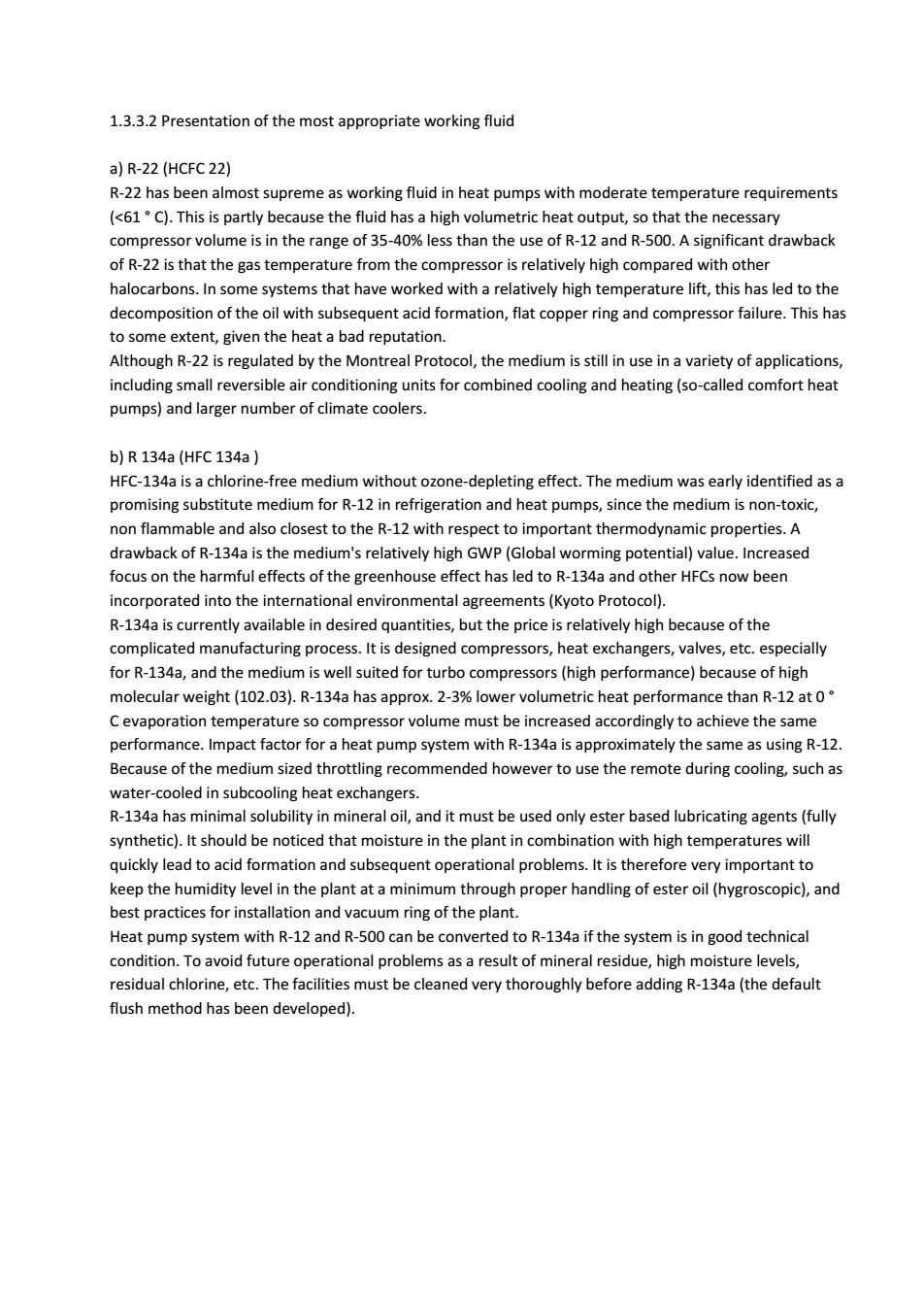正在加载图片...

1.3.3.2 Presentation of the most appropriate working fluid a)R-22(HCFC 22) R-22 has been almost supreme as working fluid in heat pumps with moderate temperature requirements (<61C).This is partly because the fluid has a high volumetric heat output,so that the necessary compressor volume is in the range of 35-40%less than the use of R-12 and R-500.A significant drawback of R-22 is that the gas temperature from the compressor is relatively high compared with other halocarbons.In some systems that have worked with a relatively high temperature lift,this has led to the decomposition of the oil with subsequent acid formation,flat copper ring and compressor failure.This has to some extent,given the heat a bad reputation. Although R-22 is regulated by the Montreal Protocol,the medium is still in use in a variety of applications, including small reversible air conditioning units for combined cooling and heating(so-called comfort heat pumps)and larger number of climate coolers. b)R 134a(HFC 134a HFC-134a is a chlorine-free medium without ozone-depleting effect.The medium was early identified as a promising substitute medium for R-12 in refrigeration and heat pumps,since the medium is non-toxic, non flammable and also closest to the R-12 with respect to important thermodynamic properties.A drawback of R-134a is the medium's relatively high GWP(Global worming potential)value.Increased focus on the harmful effects of the greenhouse effect has led to R-134a and other HFCs now been incorporated into the international environmental agreements(Kyoto Protocol). R-134a is currently available in desired quantities,but the price is relatively high because of the complicated manufacturing process.It is designed compressors,heat exchangers,valves,etc.especially for R-134a,and the medium is well suited for turbo compressors(high performance)because of high molecular weight(102.03).R-134a has approx.2-3%lower volumetric heat performance than R-12 at 0 C evaporation temperature so compressor volume must be increased accordingly to achieve the same performance.Impact factor for a heat pump system with R-134a is approximately the same as using R-12. Because of the medium sized throttling recommended however to use the remote during cooling,such as water-cooled in subcooling heat exchangers. R-134a has minimal solubility in mineral oil,and it must be used only ester based lubricating agents(fully synthetic).It should be noticed that moisture in the plant in combination with high temperatures will quickly lead to acid formation and subsequent operational problems.It is therefore very important to keep the humidity level in the plant at a minimum through proper handling of ester oil(hygroscopic),and best practices for installation and vacuum ring of the plant. Heat pump system with R-12 and R-500 can be converted to R-134a if the system is in good technical condition.To avoid future operational problems as a result of mineral residue,high moisture levels, residual chlorine,etc.The facilities must be cleaned very thoroughly before adding R-134a(the default flush method has been developed).1.3.3.2 Presentation of the most appropriate working fluid a) R-22 (HCFC 22) R-22 has been almost supreme as working fluid in heat pumps with moderate temperature requirements (<61 ° C). This is partly because the fluid has a high volumetric heat output, so that the necessary compressor volume is in the range of 35-40% less than the use of R-12 and R-500. A significant drawback of R-22 is that the gas temperature from the compressor is relatively high compared with other halocarbons. In some systems that have worked with a relatively high temperature lift, this has led to the decomposition of the oil with subsequent acid formation, flat copper ring and compressor failure. This has to some extent, given the heat a bad reputation. Although R-22 is regulated by the Montreal Protocol, the medium is still in use in a variety of applications, including small reversible air conditioning units for combined cooling and heating (so-called comfort heat pumps) and larger number of climate coolers. b) R 134a (HFC 134a ) HFC-134a is a chlorine-free medium without ozone-depleting effect. The medium was early identified as a promising substitute medium for R-12 in refrigeration and heat pumps, since the medium is non-toxic, non flammable and also closest to the R-12 with respect to important thermodynamic properties. A drawback of R-134a is the medium's relatively high GWP (Global worming potential) value. Increased focus on the harmful effects of the greenhouse effect has led to R-134a and other HFCs now been incorporated into the international environmental agreements (Kyoto Protocol). R-134a is currently available in desired quantities, but the price is relatively high because of the complicated manufacturing process. It is designed compressors, heat exchangers, valves, etc. especially for R-134a, and the medium is well suited for turbo compressors (high performance) because of high molecular weight (102.03). R-134a has approx. 2-3% lower volumetric heat performance than R-12 at 0 ° C evaporation temperature so compressor volume must be increased accordingly to achieve the same performance. Impact factor for a heat pump system with R-134a is approximately the same as using R-12. Because of the medium sized throttling recommended however to use the remote during cooling, such as water-cooled in subcooling heat exchangers. R-134a has minimal solubility in mineral oil, and it must be used only ester based lubricating agents (fully synthetic). It should be noticed that moisture in the plant in combination with high temperatures will quickly lead to acid formation and subsequent operational problems. It is therefore very important to keep the humidity level in the plant at a minimum through proper handling of ester oil (hygroscopic), and best practices for installation and vacuum ring of the plant. Heat pump system with R-12 and R-500 can be converted to R-134a if the system is in good technical condition. To avoid future operational problems as a result of mineral residue, high moisture levels, residual chlorine, etc. The facilities must be cleaned very thoroughly before adding R-134a (the default flush method has been developed)